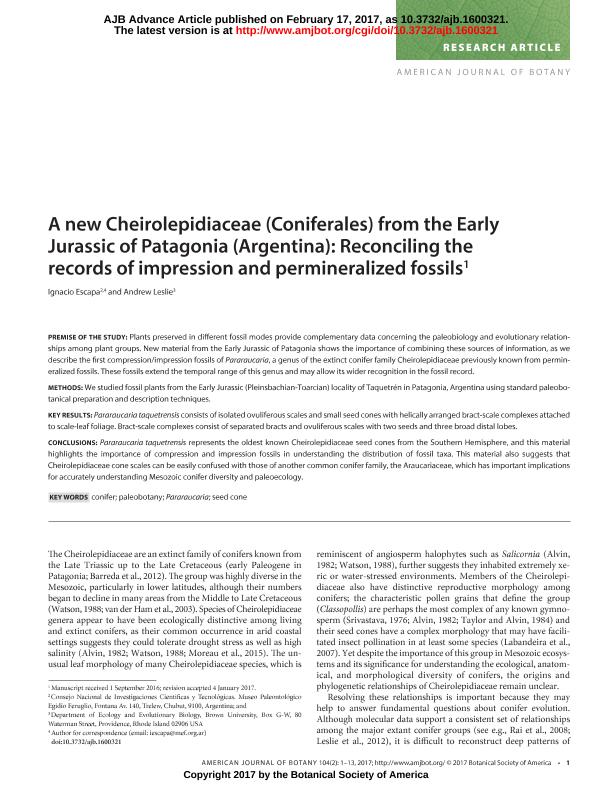Mostrar el registro sencillo del ítem
dc.contributor.author
Escapa, Ignacio Hernán

dc.contributor.author
Leslie, Andrew
dc.date.available
2018-04-04T17:38:07Z
dc.date.issued
2017-02
dc.identifier.citation
Escapa, Ignacio Hernán; Leslie, Andrew; A new cheirolepidiaceae (Coniferales) from the early jurassic of patagonia (argentina): Reconciling the records of impression and permineralized fossils; Botanical Society of America; American Journal of Botany; 104; 2; 2-2017; 322-334
dc.identifier.issn
0002-9122
dc.identifier.uri
http://hdl.handle.net/11336/40738
dc.description.abstract
PREMISE OF THE STUDY: Plants preserved in different fossil modes provide complementary data concerning the paleobiology and evolutionary relationships among plant groups. New material from the Early Jurassic of Patagonia shows the importance of combining these sources of information, as we describe the first compression/impression fossils of Pararaucaria, a genus of the extinct conifer family Cheirolepidiaceae previously known from permineralized fossils. These fossils extend the temporal range of this genus and may allow its wider recognition in the fossil record. METHODS: We studied fossil plants from the Early Jurassic (Pleinsbachian-Toarcian) locality of Taquetrén in Patagonia, Argentina using standard paleobo-tanical preparation and description techniques. KEY RESULTS: Pararaucaria taquetrensis consists of isolated ovuliferous scales and small seed cones with helically arranged bract-scale complexes attached to scale-leaf foliage. Bract-scale complexes consist of separated bracts and ovuliferous scales with two seeds and three broad distal lobes. CONCLUSIONS: Pararaucaria taquetrensis represents the oldest known Cheirolepidiaceae seed cones from the Southern Hemisphere, and this material highlights the importance of compression and impression fossils in understanding the distribution of fossil taxa. This material also suggests that Cheirolepidiaceae cone scales can be easily confused with those of another common conifer family, the Araucariaceae, which has important implications for accurately understanding Mesozoic conifer diversity and paleoecology.
dc.format
application/pdf
dc.language.iso
eng
dc.publisher
Botanical Society of America

dc.rights
info:eu-repo/semantics/openAccess
dc.rights.uri
https://creativecommons.org/licenses/by-nc-sa/2.5/ar/
dc.subject
Conifer
dc.subject
Paleobotany
dc.subject
Pararaucaria
dc.subject
Seed Cone
dc.subject.classification
Meteorología y Ciencias Atmosféricas

dc.subject.classification
Ciencias de la Tierra y relacionadas con el Medio Ambiente

dc.subject.classification
CIENCIAS NATURALES Y EXACTAS

dc.title
A new cheirolepidiaceae (Coniferales) from the early jurassic of patagonia (argentina): Reconciling the records of impression and permineralized fossils
dc.type
info:eu-repo/semantics/article
dc.type
info:ar-repo/semantics/artículo
dc.type
info:eu-repo/semantics/publishedVersion
dc.date.updated
2018-04-04T14:20:09Z
dc.journal.volume
104
dc.journal.number
2
dc.journal.pagination
322-334
dc.journal.pais
Estados Unidos

dc.journal.ciudad
St. Louis
dc.description.fil
Fil: Escapa, Ignacio Hernán. Consejo Nacional de Investigaciones Científicas y Técnicas; Argentina. Museo Paleontológico Egidio Feruglio; Argentina
dc.description.fil
Fil: Leslie, Andrew. University Brown; Estados Unidos
dc.journal.title
American Journal of Botany

dc.relation.alternativeid
info:eu-repo/semantics/altIdentifier/doi/http://dx.doi.org/10.3732/ajb.1600321
dc.relation.alternativeid
info:eu-repo/semantics/altIdentifier/url/https://onlinelibrary.wiley.com/doi/abs/10.3732/ajb.1600321
Archivos asociados
